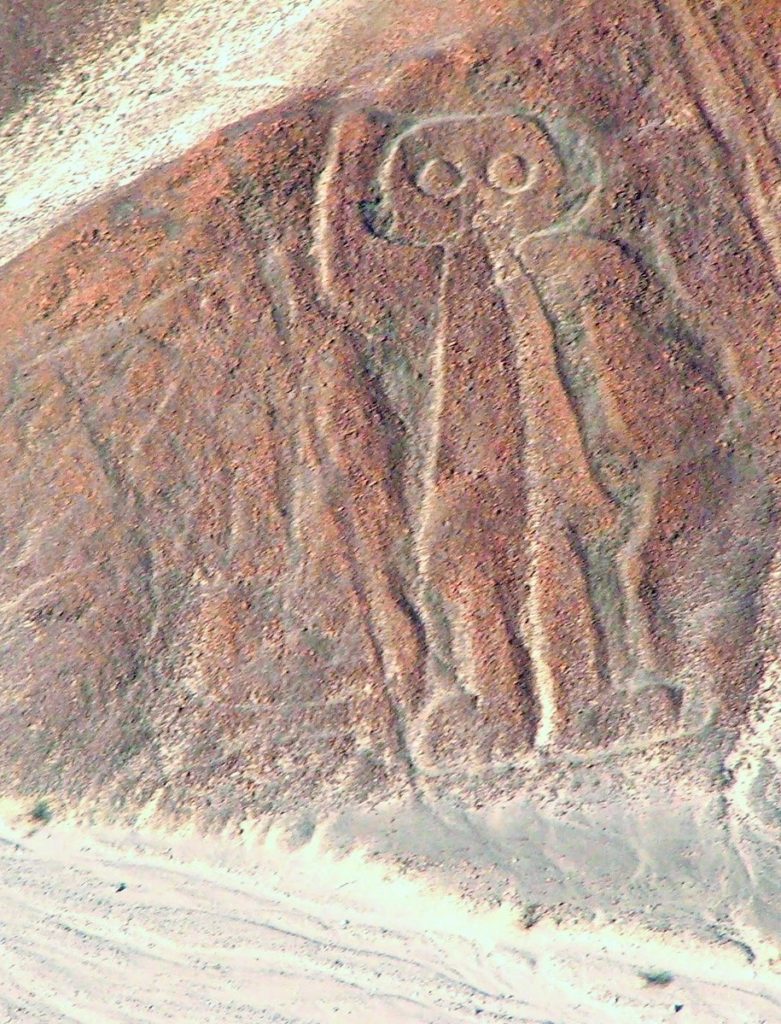I woke early as I typically do whether I’m on vacation or not and this provided a few hours between the time I finished eating breakfast and my scheduled pickup for the 25-minute ride to the airport in Pisco whence I’d start my flight over the Nazca Lines. As I noted in the previous post, the hotel has its own museum and it’s accessible with your room key so it was there that I spent most of those hours.
The museum houses a collection of more than 500 pre-Columbian artifacts including pottery, textiles, metal work, and feather art all of which is, as one would expect, quite well preserved. It also has a substantial collection of local and global seashells. I spent about two hours there and included photos from that visit in the last post. (I’ll link you to the full album later in this one.) Now for the main event.
The Nazca Lines
The large series of geoglyphs spread across 50 square kilometers on the Pampa de Nazca were largely ignored or little known and didn’t come to the attention of historians until 1926 when the Peruvian archaeologist Toribio Mejia Xesspe became the first person to systematically study them. It’s likely Xesspe didn’t grasp their full significance or dramatic impact since his study was limited by his ground-based view. In the subsequent decade, pilots flying commercial planes over Peru saw the patterns and brought them added public attention.
Then, on 22 June 1941, Paul Kosok, a professor of history at Long Island University Brooklyn, watched the sunset after a day spent studying the lines and noticed that it was directly aligned with one of them. Thinking this alignment on the winter solstice couldn’t be coincidental, he became the first to claim that the Nazca geoglyphs were, “the largest astronomy book in the world.” The theory that the builders of the lines used them as a solar calendar and as an observatory for other astronomical cycles was forcefully propagated for the next 40 years by Kosok’s one-time assistant, Maria Reiche, a German who, due to her passion and intensive study, came to be called the Lady of the Lines.
(The monkey isn’t the first pattern we overflew but I chose it as the first picture to share because a look at its tail should remind you of the sign welcoming us to Perú that you saw if you read this post.)
The large series of geoglyphs spread across 50 square kilometers on the Pampa de Nazca first came to my attention when, as a credulous teenager, I read Erich von Däniken’s book Chariots of the Gods?. In it, he proposes that extraterrestrial beings shared advanced technologies that allowed ancient societies to build structures that they otherwise could not have constructed. These included the Egyptian pyramids, Stonehenge in England, the Mo’ai of Easter Island, and, of course, the Nazca Lines. (Although I don’t recall any mention of the great neolithic structures on Malta, at least von Däniken wasn’t so Eurocentric that he limited alien attribution only to non-European cultures.)
His theory about the lines was that aliens had visited the Nazca people and the lines were their attempt to guide the aliens when they returned. He placed particular focus and emphasis on the lone human-like shape that, to this day, is called the Astronaut as support for his theory.
(My zoom shot cropped and enhanced for contrast.)
It doesn’t appear that he gave much thought to exploring and understanding the actual construction techniques needed to create the glyphs (or any of the other ancient wonders), however, because in this case the process was, in fact, rather simple.
Planting wooden stakes (at least one of which has been found and carbon dated) in the ground along the routes and at the ends of the lines created the pattern. The artists or priests or whoever was responsible then removed the oxidized surface pebbles exposing the yellowish soil beneath et voila! Not simple lines but figures in the sand.
The channels themselves are between 10 and 15 centimeters deep and more than half of them are between 30 and 35 centimeters wide. The widest lines span about 1.8 meters. A combination of arid climate and high levels of lime in the soil has prevented significant erosion and preserved them for more than 2,000 years.
As I noted above, I was considerably more credulous in those days and it was the time of Star Trek so I desperately wanted to believe in the reality of technologically advanced aliens visiting Earth so wrapped myself in it layer by layer. By college I had shed the skin of that naiveté. I believe I am both richer and poorer for it.

